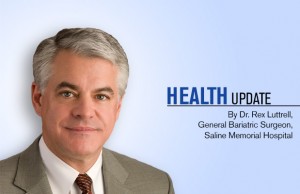Health Update: Care For Your Aging Spine

Getting older hurts—literally. As we age, it’s often evident that our bodies don’t function like they did in our teens or 20s. The general aches and pains become more pronounced and daily activities can become limited or painful. One of the common aches treated as we get older involves the back or spine.
Your spine, or backbone, is very important to your overall physical health. This is what allows you to stand and bend.
Spinal stenosis is a very common condition that affects most of us as we age. Spinal stenosis is the name given to the process of narrowing around the nerves in our necks and backs. It results in pinching of the central nerves (spinal cord or caudal equina), and nerves that peel off of the major nerves to run down the arms and legs. This occurs to us all at various degrees, the older we get. It occurs because as we age, the bones, cartilage, and discs that surround our spinal nerves begin to over-grow, much like the onset of bone spurs that occurs in the development of arthritis around knees, hands, etc.
At first, this process of nerve pinching is slowly progressive, is without symptoms, and isn’t noticed. However, over time, when the nerves have been pinched beyond the point that our bodies can accommodate to that compression, symptoms begin to develop. This may result in neck or back pain, fatigue in the muscles that hold us upright and run along the spine, fatigue to the legs and arms, pain, tingling numbness or weakness to the arms or legs. Or when severe, bowel or bladder dysfunction, such as incomplete emptying, increased frequency, urgency, and even frank incontinence can occur.
Often, patients begin to take a posture of being slightly too significantly bent forward. You have probably seen folks in the grocery store, pushing a cart, bent over while they shop. This position of the spine takes some of the pressure off of the nerves, and often people don’t even realize that they have become more and more stooped over. Typically, before the most severe of symptoms show up, people have sought care. The good news is that treatment is often helpful in alleviating the symptoms and allowing patients to return to normal activities.
Treatment for spinal stenosis starts with exercises to help strengthen the muscles of the spine, taught by physical therapists and chiropractors. Patients often falsely think that physical therapy or chiropractic will solve their problems. In reality, what is taught in PT or the chiropractor’s office is just the beginning. It is often necessary to continue to do the exercises taught for the rest of one’s life.
When PT/chiropractic proves unsuccessful in relieving the symptoms, medications and even steroid injections may be tried. However, if symptoms continue despite these efforts, surgery is very often successful in patients for whom simpler measures haven’t helped. Surgery can very often be minimally invasive through a small incision for most patients. Occasionally, when stability of the spine has been affected by the arthritic, degenerative process, a bigger surgery to stabilize the spine as well as to take pressure off of the nerves is necessary. In the vast majority of patients who have had treatment, symptoms can be improved and life can to return to a more normal rhythm.
Whether you’re a competitive athlete, a crossfitter or the everyday gym-goer, lower back and neck pain is something that can be crippling. True, some aches and pains are inevitable as we age. However, if you are suffering from chronic back pain that is affecting your health, know that there are options that can help.










0 comments